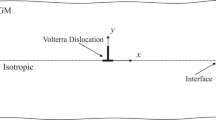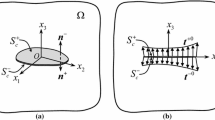Abstract
The paper is devoted to the problem of slow crack growth in heterogeneous media. The crack is subjected to arbitrary pressure distribution on the crack surface. The problem relates to construction of the so-called equilibrium crack. For such a crack, stress intensity factors are equal to the material fracture toughness at each point of the crack contour. The crack shape and size depend on spatial distributions of the elastic properties and fracture toughness of the medium, and the type of loading. In the paper, attention is focused on the case of layered elastic media when a planar crack propagates orthogonally to the layers. The problem is reduced to a system of surface integral equations for the crack opening vector and volume integral equations for stresses in the medium. For discretization of these equations, a regular node grid and Gaussian approximating functions are used. For iterative solution of the discretized equations, fast Fourier transform technique is employed. An iteration process is proposed for the construction of the crack shape in the process of crack growth. Examples of crack evolution for various properties of medium and types of loading are presented.















Similar content being viewed by others
References
Duarte C, Hamzeh O, Liszka T, Tworzydlo W (2001) A generalized finite element method for the simulation of three-dimensional dynamic crack propagation. Comput Methods Appl Mech Eng 190(15):2227–2262
Fries T, Belytschko T (2010) The extended/generalized finite element method: an overview of the method and its applications. Int J Numer Methods Eng 84(3):253–304
Gao H, Rice J (1989) A first-order perturbation analysis of crack trapping by arrays of obstacles. J Appl Mech 56:828–836
Golub G, van Loan C (1996) Matrix computations, 3rd edn. The Johns Hopkins University Press, London
Kanaun S (1981) Elastic problem for 3D-anisotropic medium with a crack. Appl Math Mech (PMM) 45:361–370
Kanaun S (2007) Fast solution of the 3D elasticity problem for a planar crack of arbitrary shape. Int J Fract 148:435–442
Kanaun S (2017) Hydraulic fracture crack propagation in an elastic medium with varying fracture toughness. Int J Eng Sci 120:15–30
Kanaun S, Levin V (2008) Self-consistent methods for composites I, static problems. Springer, Dordrecht
Kanaun S, Markov A (2017) Discrete and three-parameter models of hydraulic fracture crack growth. WSEAS Trans Appl Theor Mech 12:147–156
Kanaun S, Pervago E (2011) Combining self-consistent and numerical methods for the calculation of elastic fields and effective properties of 3D-matrix composites with periodic and random microstructures. Int J Eng Sci 49(5):420–442
Kanaun S, Markov A, Babaii S (2013) An efficient numerical method for the solution of the second boundary problem of elasticity for 3D-bodies with cracks. Int J Fract 183(2):169–186
Knight M, Wrobel L, Henshall J, De Lacerda L (2002) A study of the interaction between a propagating crack and an uncoated/coated elastic inclusion using the BE technique. Int J Fract 114(1):47–61
Kunin I (1983) The theory of elastic media with microstructure II. Springer, Berlin
Lei J, Wang Y, Huang Y, Yang Q, Zhang C (2012) Dynamic crack propagation in matrix involving inclusions by a time-domain BEM. Eng Anal Bound Elem 36(5):651–657
Markov A, Kanaun S (2017) Interactions of cracks and inclusions in homogeneous elastic media. Int J Fract 206(1):35–48
Maz’ya V, Schmidt G (2007) Approximate approximation, mathematical surveys and monographs, vol 141. American Math Society, Providence
Mi Y, Aliabadi M (1994) Three-dimensional crack growth simulation using BEM. Comput Struct 52(5):871–878
Moes N, Belytschko T (2002) Extended finite element method for cohesive crack growth. Eng Fract Mech 69(7):813–833
Moes N, Dolbow J, Belytschko T (1999) Elastic crack growth in finite elements without remeshing. Int J Numer Methods Eng 46:131–150
Movchan A, Gao H, Willis J (1998) On perturbations of plane cracks. Int J Solids Struct 35(26–27):3419–3453
Press W, Flannery B, Teukolsky S, Wetterling W (1992) Numerical recipes in FORTRAN: the art of scientific computing. Cambridge University Press, Cambridge
Ramanathan S, Ertas D, Fisher D (1997) Quasistatic crack propagation in heterogeneous media. Phys Rev Lett 79(5):873–877
Remmers J, de Borst R, Needleman A (2003) A cohesive segments method for the simulation of crack growth. Comput Mech 31(1):69–77
Sneddon I (1946) The distribution of stress in the neighbourhood of a crack in an elastic solid. Proc R Soc Lond 187(1009):229–260
Sukumar N, Moes N, Moran B, Belytschko T (2000) Extended finite element method for three-dimensional crack modelling. Int J Numer Methods Eng 48(11):1549–1570
Williams R, Phan A, Tippur H, Kaplan T, Gray L (2007) SGBEM analysis of crack-particle(s) interactions due to elastic constants mismatch. Eng Fract Mech 74(3):314–331
Yang B, Ravi-Chandar K (1998) A single-domain dual-boundary-element formulation incorporating a cohesive zone model for elastostatic cracks. In: Recent advances in fracture mechanics, pp 115–144. Springer, Netherlands
Zhuang Z, Cheng B (2011) Equilibrium state of mode-I sub-interfacial crack growth in bi-materials. Int J Fract 170(1):27–36
Acknowledgements
This work was supported by CONACYT (Consejo Nacional de Ciencia y Tecnologia, Mexico), Project 243124, CB2014.
Author information
Authors and Affiliations
Corresponding author
Additional information
Publisher's Note
Springer Nature remains neutral with regard to jurisdictional claims in published maps and institutional affiliations.
Appendix
Appendix
The integral \({\varGamma }_{ijkl}(x)\) in Eq. (16) can be calculated in explicit analytical form. In the basis of six linearly independent four rank tensors \(E_{ijkl}^{\left( p\right) }(m)\)
the tensor \({\varGamma }_{ijkl}(x)\) takes the form
Scalar functions \(g^{\left( p\right) }(z)\) (\(p=1,2,\ldots ,6\)) in this equation are expressed in terms of three scalar functions \(\psi _{0}(z),\psi _{1}(z),\psi _{2}(z)\)
Here \(erf\left( z\right) \) is the probability integral
The integral \(I_{ijk}(x_{1},x_{2},x_{3})\) in Eq. (25) is presented in the form
Calculation of the double integral in eq (29) yields the following equation for \(I_{ijk}(\varsigma _{1},\varsigma _{2},\varsigma _{3})\):
Here \(n_{i}=n_{i}^{(s)}\) is the normal to \({\varOmega }\) at the sth node, scalar coefficients \(s_{\alpha }=s_{\alpha }(r,x_{3})\) are
Functions \(g_{1},g_{2},\ldots ,g_{9}\) in these equations are expressed in terms of five linearly independent integrals \(F_{\alpha }(r,x_{3}):\)
Here \(F_{\alpha }=F_{\alpha }(r,x_{3})\) are 1D-absolutely converging integrals (\(\rho =r/h\), \(z=x_{3}/h\))
In these equations, \(J_{n}(k\rho )\) (\(n=0,2,3\)) are Bessel functions of the first kind. Note that these functions do not depend on the node grid step h but are functions of non-dimensional variables \(\rho \) and z.
If \(x_{3}=0\), the tensor \(I_{ijk}(x_{1},x_{2},0)\) is calculated explicitly and takes the form
Here the scalar coefficients \(s_{\alpha }=s_{\alpha }(r,\varsigma _{3})\) are
The functions \(F_{\alpha }=F_{\alpha }(r)\) have the form
In these equations, \(I_{0}(z)\) and \(I_{1}(z)\) are the first kind modified Bessel functions of order 0 and 1 correspondingly, \(\rho =r/h\).
Rights and permissions
About this article
Cite this article
Markov, A., Kanaun, S. An efficient numerical method for quasi-static crack propagation in heterogeneous media. Int J Fract 212, 1–14 (2018). https://doi.org/10.1007/s10704-018-0284-9
Received:
Accepted:
Published:
Issue Date:
DOI: https://doi.org/10.1007/s10704-018-0284-9




